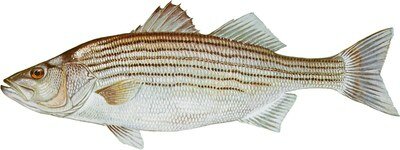Striped Bass (Morone saxatilis)
A collection of links and pages related to the Striped Bass and related recovery efforts.
Striped Bass Overview
Morone saxatilis
Lifecycle Overview
- Striped bass are anadromous, migrating into fresh or brackish water to spawn. Spawning typically occurs from April to June, with spawning activity peaking when water temperatures are between 15˚ and 20˚ C. After spawning, females will usually return to the ocean while males can remain in the estuaries. Fertilized eggs drift downstream, hatch into larvae, and eventually mature into juveniles and end up in nursery areas in river deltas, coastal sounds, and estuaries. Juveniles will remain in these areas for 2 to 4 years before moving into the ocean to join the coastal migratory population. Males mature at about 2 years of age, while females mature at about age 6. Striped bass can live up to 30 years.
Distribution/Range
- Striped bass are found from the St. Lawrence River in Canada to the St. Johns River in Florida. The stocks in the southern part of the range (Tar-Pamlico River in NC to Florida) stay within natal rivers or estuaries, where stocks from the Chesapeake Bay, Hudson River, and Delaware River undergo seasonal coastal migrations. These migrations can range from North Carolina to Nova Scotia. In Maine, it is believed that the primary spawning population is found in the Kennebec River.
History of the Fishery
- Striped bass, or stripers as they are often called, are a very important saltwater gamefish throughout their range. In Maine, historic commercial landings have not been reported since the early 1900s. While other Atlantic states have a commercial fishery for the species, commercial fishing for striped bass is currently prohibited in Maine. Overfishing and poor conditions lead to the collapse of the Atlantic migratory stocks in the 1980s, and the passage of the Atlantic Striped Bass Conservation Act. In 1995, striped bass in the Atlantic were declared restored. In recent years, recreational fishing has grown, and now accounts for a larger portion of the total catch than commercial fishing.
Current Status and Management
- The coastal migratory stocks are managed by the Atlantic States Marine Fisheries Commission (ASMFC) in accordance with the Atlantic Striped Bass Conservation Act. Recent stock assessments have suggested that while striped bass are not overfished, spawning stock biomass is in steady decline. The recreational fishery in Maine is managed by the Maine Department of Marine Resources, and specifies that striped bass can be fished for in all Maine coastal waters up to the head of tide in all rivers. Populations in Maine rivers, like the Kennebec and the Penobscot, are believed to be low due to multiple reasons, including the construction of impassable dams since the 1800s.
Current Recovery Efforts
- In October of 2014, the ASMFC approved an addendum in response to the declining stock biomass, requiring coastal states to implement a 25% harvest reduction from 2013 levels. Not much is known about the size of the population in Maine rivers, and research is trying to get a handle on native striped bass in the state. Additionally, dam removals throughout the state are hoping to restore access to historic spawning areas for multiple anadromous species, including striped bass.
Links, Useful documents
- NOAA Status of Fishery Resources off the Northeastern US - Striped Bass
http://www.nefsc.noaa.gov/sos/spsyn/af/sbass/ - Atlantic States Marine Fisheries Commission - Atlantic Striped Bass
http://www.asmfc.org/species/atlantic-striped-bass - Information about the Atlantic Striped Bass Conservation Act
http://www.nmfs.noaa.gov/sfa/state_federal/State-Federal-WEB/asbca.htm - Saltwater Recreational Angling Regulations in Maine
http://www.maine.gov/dmr/recreational/regulations.htm
Prepared by:
Lisa Izzo
University of Maine
American Fisheries Society Student Subunit
Document Actions


